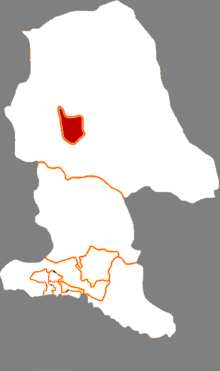Bayan obo
| Mongolian name | |
|---|---|
| Mongolian script : | ᠪᠠᠶᠠᠨ ᠣᠪᠣᠭ᠋ᠠ ᠠᠭᠤᠷᠬᠠᠢ ᠶᠢᠨ ᠲᠣᠭᠣᠷᠢᠭ |
| Transliteration: | bayan oboɣ-a aɣurqai-yin toɣoriɣ |
| Cyrillic script : | Баян Овоо Уурхайн дүүрэг |
| ISO transliteration : | Baân Ovoo Uurxajn dùùrèg |
| Transcription: | Bajan Owoo Uurchajn düüreg |
| Chinese name | |
| Simplified : | 白云鄂博 矿区 、 白云 矿区 |
| Pinyin : | Báiyún'èbó Kuàngqū, Báiyún Kuàngqū |
The Bayan Obo mining district (from bayan "rich" and Obo ) is a district of the prefecture-level city of Baotou in the Inner Mongolia Autonomous Region of the People's Republic of China . Bayan Obo has an area of 303 km² and has a population of 20,000.
Ore deposits
In the north of Bayan Obo, there are rich deposits of rare earths in metamorphic rocks of the Upper Proterozoic , which are mined in open-cast mining.
The ore mines were discovered in the 1920s and contain ores made from iron, rare earths, and niobium . China's largest iron ore deposits are located here, with reserves of more than a billion tons. The reserves of rare earth ores exceed 35 million tons. These consist mainly (80%) of bastnesite and monazite with a rare earth content between 1 and 6.2%. Since the thorium content in monazite from this source is only 0.26%, while the rare earth oxide and phosphate content is more than 98%, it is a popular variety for the production of rare earth metals. The bastnesite also has a thorium content of only 0.02 to 0.28%.
Individual evidence
- ↑ Kurt Friehauf: Geologic investigation of the Baiyunebo Rare Earth Element District, Inner Mongolia, China . ( June 15, 2010 memento on the Internet Archive ) Kutztown University of Pennsylvania
- ^ CK Gupta, N. Krishnamurthy, Extactive Metallurgy of Rare Earths , CRC Press, 2005, ISBN 0-415-33340-7
Web links
Coordinates: 41 ° 46 ' N , 109 ° 58' E
